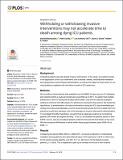| dc.contributor.author | Ramazzotti, Daniele | |
| dc.contributor.author | Clardy, Peter | |
| dc.contributor.author | Celi, Leo Anthony G. | |
| dc.contributor.author | Stone, David J. | |
| dc.contributor.author | Rudin, Robert S. | |
| dc.date.accessioned | 2019-06-25T16:57:44Z | |
| dc.date.available | 2019-06-25T16:57:44Z | |
| dc.date.issued | 2019-02 | |
| dc.date.submitted | 2018-08 | |
| dc.identifier.issn | 1932-6203 | |
| dc.identifier.uri | https://hdl.handle.net/1721.1/121407 | |
| dc.description.abstract | This is an open access article distributed under the terms of the Creative Commons Attribution License, which permits unrestricted use, distribution, and reproduction in any medium, provided the original author and source are credited. Background Critically ill patients may die despite invasive intervention. In this study, we examine trends in the application of two such treatments over a decade, namely, endotracheal ventilation and vasopressors and inotropes administration, as well as the impact of these trends on survival durations in patients who die within a month of ICU admission. Methods We considered observational data available from the MIMIC-III open-access ICU database and collected within a study period between year 2002 up to 2011. If a patient had multiple admissions to the ICU during the 30 days before death, only the first stay was analyzed, leading to a final set of 6,436 unique ICU admissions during the study period. We tested two hypotheses: (i) administration of invasive intervention during the ICU stay immediately preceding end-of-life would decrease over the study time period and (ii) time-to-death from ICU admission would also decrease, due to the decrease in invasive intervention administration. To investigate the latter hypothesis, we performed a subgroups analysis by considering patients with lowest and highest severity. To do so, we stratified the patients based on their SAPS I scores, and we considered patients within the first and the third tertiles of the score. We then assessed differences in trends within these groups between years 2002–05 vs. 2008–11. Results Comparing the period 2002–2005 vs. 2008–2011, we found a reduction in endotracheal ventilation among patients who died within 30 days of ICU admission (120.8 vs. 68.5 hours for the lowest severity patients, p<0.001; 47.7 vs. 46.0 hours for the highest severity patients, p = 0.004). This is explained in part by an increase in the use of non-invasive ventilation. Comparing the period 2002–2005 vs. 2008–2011, we found a reduction in the use of vasopressors and inotropes among patients with the lowest severity who died within 30 days of ICU admission (41.8 vs. 36.2 hours, p<0.001) but not among those with the highest severity. Despite a reduction in the use of invasive interventions, we did not find a reduction in the time to death between 2002–2005 vs. 2008–2011 (7.8 days vs. 8.2 days for the lowest severity patients, p = 0.32; 2.1 days vs. 2.0 days for the highest severity patients, p = 0.74). Conclusion We found that the reduction in the use of invasive treatments over time in patients with very poor prognosis did not shorten the time-to-death. These findings may be useful for goals of care discussions. | en_US |
| dc.description.sponsorship | National Institutes of Health (U.S.) (Grant EB017205-01A1) | en_US |
| dc.publisher | Public Library of Science | en_US |
| dc.relation.isversionof | http://dx.doi.org/10.1371/journal.pone.0212439 | en_US |
| dc.rights | Creative Commons Attribution 4.0 International license | en_US |
| dc.rights.uri | https://creativecommons.org/licenses/by/4.0/ | en_US |
| dc.source | PLoS | en_US |
| dc.title | Withholding or withdrawing invasive interventions may not accelerate time to death among dying ICU patients | en_US |
| dc.type | Article | en_US |
| dc.identifier.citation | Ramazzotti, Daniele et al. “Withholding or Withdrawing Invasive Interventions May Not Accelerate Time to Death Among Dying ICU Patients.” Edited by Shane Patman. PLOS ONE 14, 2 (February 2019): e0212439 © 2019 Ramazzotti et al. | en_US |
| dc.contributor.department | Massachusetts Institute of Technology. Institute for Medical Engineering & Science | en_US |
| dc.relation.journal | PLOS ONE | en_US |
| dc.eprint.version | Final published version | en_US |
| dc.type.uri | http://purl.org/eprint/type/JournalArticle | en_US |
| eprint.status | http://purl.org/eprint/status/PeerReviewed | en_US |
| dc.date.updated | 2019-03-25T15:20:00Z | |
| dspace.orderedauthors | Ramazzotti, Daniele; Clardy, Peter; Celi, Leo Anthony; Stone, David J.; Rudin, Robert S. | en_US |
| dspace.embargo.terms | N | en_US |
| dspace.date.submission | 2019-04-04T11:07:17Z | |
| mit.journal.volume | 14 | en_US |
| mit.journal.issue | 2 | en_US |
| mit.license | PUBLISHER_CC | en_US |
